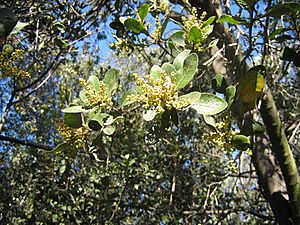Lithraea caustica facts for kids
Quick facts for kids Lithraea caustica |
|
|---|---|
 |
|
| Scientific classification | |
| Genus: |
Lithraea
|
| Species: |
caustica
|
The Lithraea caustica is a special plant often called the Litre tree. People also used to call it llithi or liti. It's a type of flowering plant that belongs to the cashew family, called Anacardiaceae. This plant only grows in central Chile. You can find it in places like La Campana National Park. The Litre tree is known to cause a skin rash in people who touch it. How badly it affects someone can be very different from person to person.
Contents
What the Litre Tree Looks Like
The Litre tree is an evergreen plant. This means it keeps its leaves all year round. Its leaves are oval-shaped and can have smooth or wavy edges.
If left alone, it can grow into a full tree. In the past, it was common to see it as a tree. But now, you usually find it as a shrub. This is because of how land is used today. Its leaves feel tough, almost like leather. This is because they have a lot of special materials called lignin and cellulose.
The Litre tree has large, underground parts called burls. If the plant is cut down or burned, new growth can come out from these burls. Many other woody plants in its region share this amazing ability.
Why the Litre Tree Can Be Itchy
The leaves and branches of the Litre tree can cause a bad skin rash. This happens if they touch human skin. The rash often makes the skin swell up and feel very itchy.
The part of the plant that causes this reaction is called litreol. It's a chemical similar to the ones found in poison oak and poison ivy. This is why touching the Litre tree can make you itch!
Where the Litre Tree Grows and Lives
The Litre tree grows in matorral climates. These are areas that have a climate similar to the southern Mediterranean. The Litre tree grows in more places across Central Chile than any other shrub in its region. It has been found to grow even more when animals graze nearby.
How the Litre Tree Reproduces
This plant spreads by sending out new seedlings. Birds like the Austral thrush, Mimus thenca, and Phytotoma rara help spread its seeds. Foxes (Pseudalopex species) also help to move the seeds around.
The Litre tree can handle dry weather very well. This is because it has a deep and wide root system. Its roots can reach far down to find water.
Because the Litre tree is toxic, it is often left alone by animals. This means it is one of the least disturbed plants in its natural homes. Scientists have found that the plant and the soil around it are home to many different kinds of beetles. There are 29 families, 57 genera, and 69 species of beetles living there!
A Bit of Litre Tree History
Scientists have known about the Litre tree for a long time. It was first written about in the early 1700s. An explorer and botanist named Louis Feuillée wrote about it. He said that sailors on his trip got very bad reactions after cutting down some 'Llithi' trees.
The plant was given its first scientific name, Laurus caustica, in 1832. This name was given by William Jackson Hooker and George Arnott Walker-Arnott.
See also
 In Spanish: Litre para niños
In Spanish: Litre para niños

